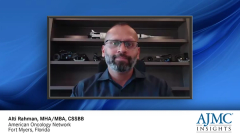
Opinion|Videos|January 3, 2025
Team- and System-Based Approaches to Managing LEMS and Ensuring Access
A panelist discusses how comprehensive care coordination between specialists, proactive adverse effect management, and innovative care models can optimize treatment outcomes for Lambert-Eaton myasthenic syndrome (LEMS) patients, particularly those with dual diagnoses like small cell lung cancer (SCLC), while ensuring both clinical effectiveness and cost-efficiency through managed care strategies.
Advertisement
Episodes in this series

Video content above is prompted by the following:
- How can health care teams proactively manage adverse effects associated with treatments like amifampridine?
- How can managed care organizations facilitate timely access to LEMS therapies while ensuring cost-effectiveness?
- What strategies can improve communication and coordination between oncologists, neurologists, and pharmacists in managing dual-diagnosis patients?
- What innovative care models have shown promise in improving outcomes for patients with dual diagnoses like SCLC and LEMS?
Newsletter
Stay ahead of policy, cost, and value—subscribe to AJMC for expert insights at the intersection of clinical care and health economics.
Advertisement
Latest CME
Advertisement
Advertisement
Trending on AJMC
1
Clascoterone 5% Delivers Strong Phase 3 Results for Androgenetic Alopecia
2
Cardiotoxicity Remains a Concern as Breast Cancer Survival Rates Improve: Eric H. Yang, MD
3
FDA Approves Inebilizumab for Generalized Myasthenia Gravis
4
Pirtobrutinib Outperforms Bendamustine-Rituximab in Frontline CLL/SLL
5











































